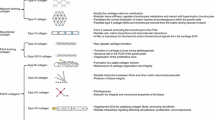Abstract
This contribution reviews the structure and organization of collagen molecules found in cartilage and the roles that they may play in rheumatic diseases. Cartilage is unique in its physical properties and molecular composition, and contains sufficient amounts of types II, IX, X, and XI collagen to deem these molecules as ”cartilage-specific.” The vitreous body of the eye, a ”cartilagelike” tissue is also rich in the same collagens but is type X deficient. Types VI and XII collagen are present in cartilage as well as noncartilaginous tissues. Types II, IX, and XI collagen are organized into matrix fibrils, where type II constitutes the bulk of the fibril, type XI regulates fibril size, and type IX facilitates fibril interaction with proteoglycan macromolecules. Genetic defects in these collagens can produce mild to severe developmental abnormalities, including spondyloepiphyseal dysplasia often accompanied by an accelerated form of osteoarthritis. Sensitization with collagen can produce experimental rheumatic diseases. Type II collagen induces an erosive polyarthritis in certain strains of rats, mice, and higher primates which can resemble rheumatoid arthritis and relapsing polychondritis. Type XI collagen is arthritogenic in rats but not mice; type IX induces autoimmunity in both species but not arthritis. Arthritis is initiated by complement fixing antibodies that bind to type II collagen in autologous cartilage, and the production of these antibodies is MHC restricted and T cell dependent. It is unclear whether T cells alone can induce arthritis, although they probably help sustain it. Mapping and characterizing the of T cell epitopes on type II collagen has resulted in the synthesis of small homolog and substituted peptides of type II collagen which suppress arthritis in an antigen-specific manner by a variety of routes, including mucosal. Moreover, collagen-induced arthritis has proven a valuable model to study the contribution of cytokines and other biological agents in the pathogenesis of joint injury and how they might be used to develop new therapies. Collagen autoimmunity has been implicated in the pathogenesis rheumatoid arthritis and polychondritis. Circulating antibodies to type II collagen are found in both diseases. Antibodies to types IX and XI collagen are also present in rheumatoid sera but are less prevalent. Rheumatoid cartilage and synovium contain antibodies to type II collagen at a prevalence far greater than serum, suggesting an intra-articular antigen-driven immune process. Although effective in animal models, attempts to treat rheumatoid arthritis with orally administered type II collagen have proven elusive. Different approaches using newer formulations and selected or modified oligopeptides remain to be tested and could prove effective in the treatment of the human rheumatic diseases.
Similar content being viewed by others
Author information
Authors and Affiliations
Additional information
Received: 16 April 1997 / Accepted: 15 January 1998
Rights and permissions
About this article
Cite this article
Cremer, M., Rosloniec, E. & Kang, A. The cartilage collagens: a review of their structure, organization, and role in the pathogenesis of experimental arthritis in animals and in human rheumatic disease. J Mol Med 76, 275–288 (1998). https://doi.org/10.1007/s001090050217
Issue Date:
DOI: https://doi.org/10.1007/s001090050217



